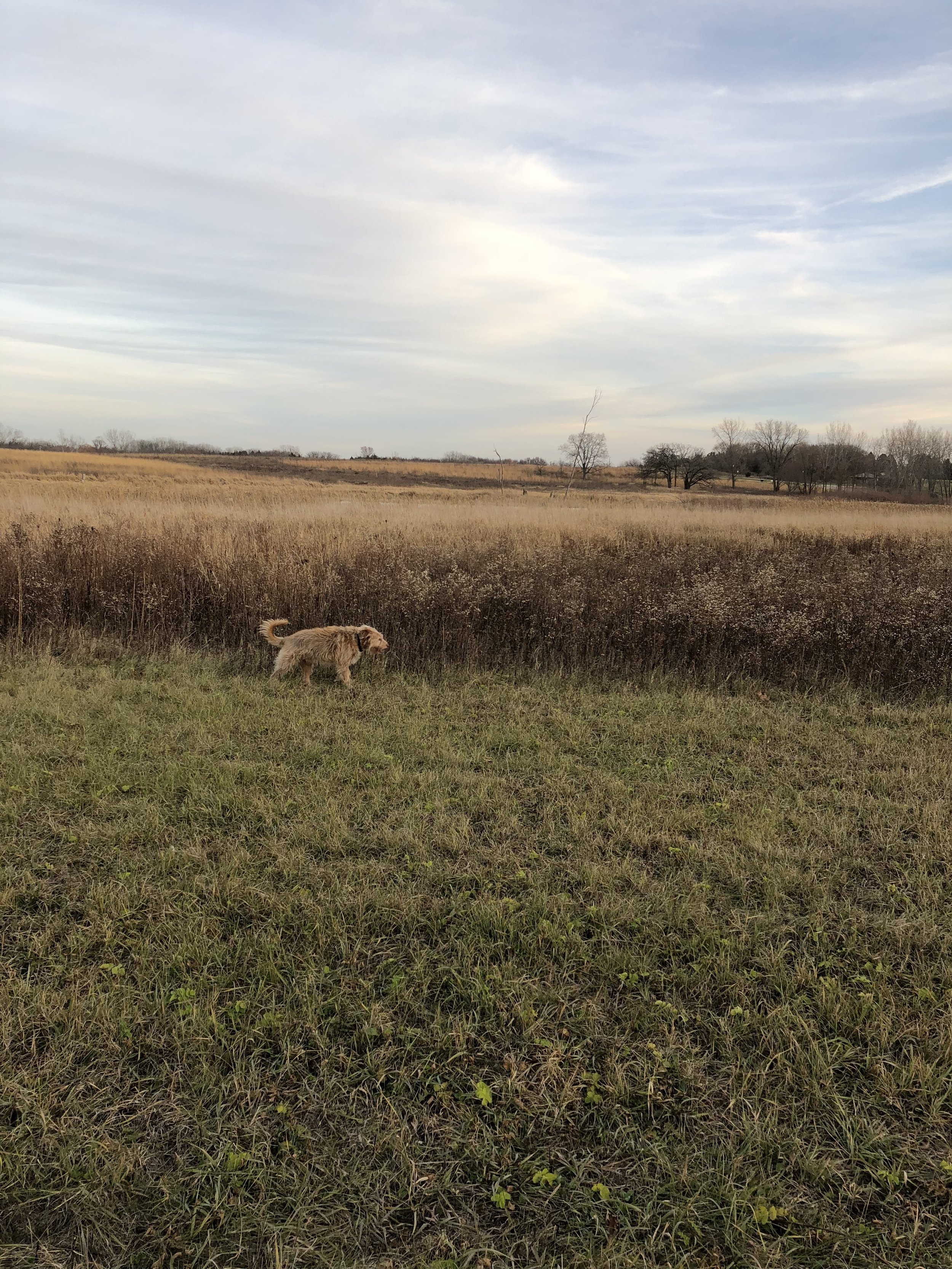Pax’s Prairie
Another cloudless, unseasonably pleasant day.
~~~~~~~~~~~~~~~~
Pax’s Prairie
You can get lost in a prairie. Well, Pax can’t because he can “see” with his nose, and being in very tall grass does not inconvenience him. But I could get lost if this prairie were just a little bigger and I wandered off the paths. Early settlers to this part of the world sometimes did get lost on the tall grass prairie, the sea of grass, and had to be careful. If you were in the thick of it, you had to be up on a big horse to see over the top to where you wanted to go.
Pax and I like being within walking distance of a real prairie, and we like walking through it (mostly on the paths) and around it. From the top of the ridge left by the glacier 12,000 years ago it’s a wide open space with a marsh in the low part. No trees except a few burr oaks here and there. If you took 120 football fields and stuck them all together that would be about the size of it.
While it feels rather big, our prairie is really just a remnant, a little scrap of what used to be. Back before European settlement, the whole middle part of North America was prairie—from Indiana to Colorado, from Texas into Canada. People who saw it for the first time just about fell off their horses—they’ed never seen anything like it.
Who ever heard of grass seven feet tall, or saw the wind sending waves of color across miles of flowers?
The prairie biome is a unique one, caused some by climate but more by fire. Prairies like fire. Almost all prairie plants are perennials and have very deep roots. In the fall, after the seeds are dispersed, all the dry vegetation above ground becomes tinder. Once a fire gets started, it burns hot and quick, and depending on the wind, can move fast—faster than a person can walk. But this fire doesn’t bother prairie plants at all since their essential parts are below ground, sometimes extending down twelve or more feet.
All that’s left after a fire are cinders and blackened stubble. Any invading species that don’t have prairie-style roots, and any tree saplings, are toast. But come spring rain, the deep prairie roots send up new shoots, and within a few months the prairie is back better than ever and tall enough to get lost in. If it weren’t for fire most prairie would eventually turn into forest.
Lightning sometimes starts prairie fires, but actually Native Americans were responsible for much of it. They would have “fire hunts” in which they would “set fire to the grass everywhere around a herd of bison except some passage which they leave on purpose and where they take post with their bows and arrows.” (said Father Louis Hennepin in 1680)
Tall grass prairie is called tall grass because of all the tall grass, but a prairie is really a mix of grass and other kinds of plants called forbs. Forbs are non-woody, broad-leaved plants with flowers, and there are hundreds of different kinds in a healthy prairie. Some forb or other is always in flower—from earliest spring until hard frost—with blooms of yellow, blue, pink, lavender, indigo, coral, gold, magenta, crimson, and orange.
One interesting forb is rattlesnake master, which has spiky, white globes for flowers. Supposedly a decoction of leaves and roots is useful in treating snakebite. Some folks claim that snakes avoid areas with rattlesnake master, while others claim that if you see the plant you need to watch your step to avoid getting bit.
Another broad-leaved member of the prairie is the compass-plant. It has a big yellow flower on a long stalk that towers as high as ten feet. It’s called the compass-plant because most of the time the flat part of its big leaves face east and west while the narrow blade part points north and south. This is handy if you tend to get lost.
Well, I’d better stop writing, The afternoon sun is getting low, and Pax, who always knows what time it is, is poking me with his nose. This means—time to go for our prairie walk.






























